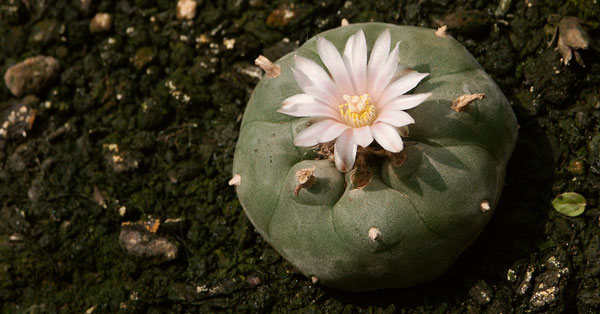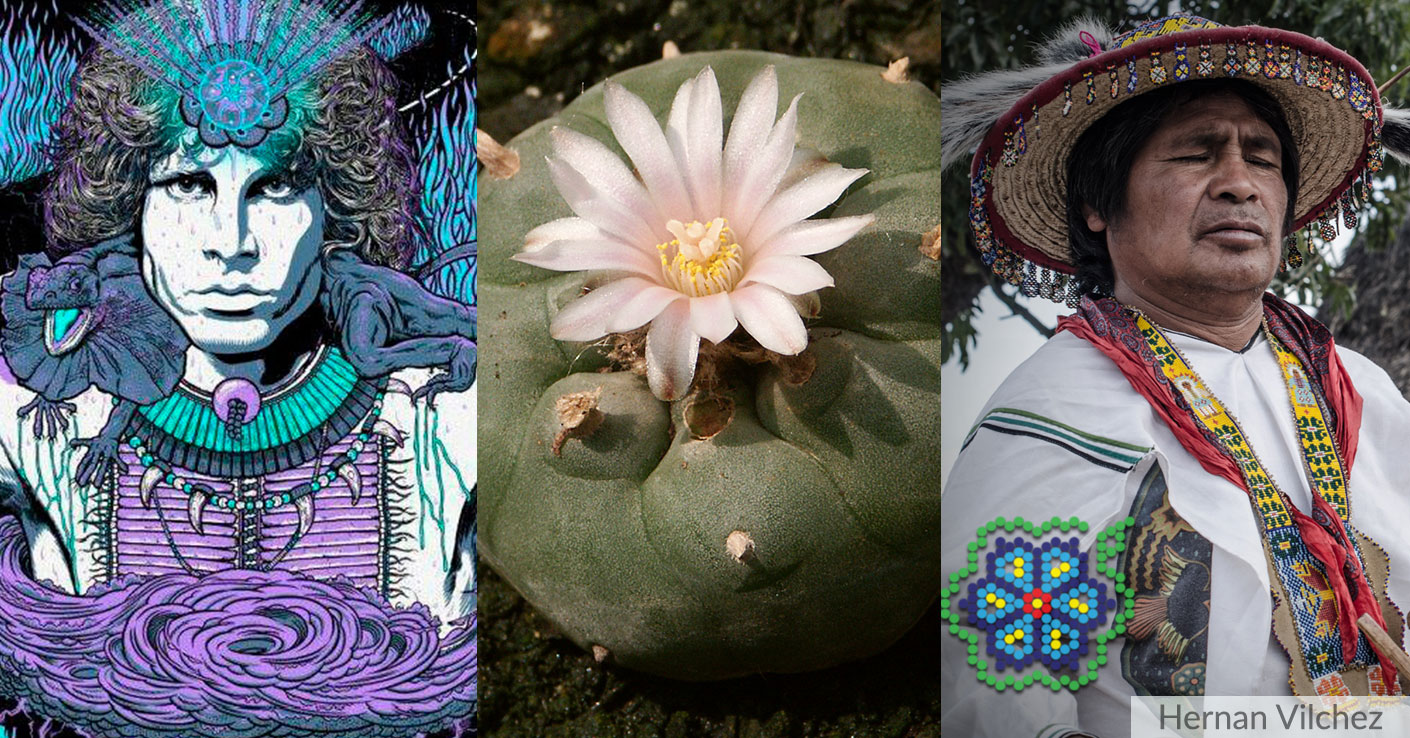- Why Land and Ecology Matter for Global Psychedelics - January 25, 2024
- Coming of Age in the Psychedelic Sixties - March 15, 2022
- Psychedelics, the War on Drugs, and Violence in Latin America - March 10, 2022
There is a scene in Oliver Stone’s 1991 film, The Doors, where the rock quartet and their female company travel to a desert and ingest peyote. The characters experience emotional instability, feel “fucked up,” and vomit. Yet, Jim Morrison (played by Val Kilmer) is the mediating force that re-focuses his peers’ psychedelic experience while the slow musical progression of “The End” plays in the background. As the song builds, Jim Morrison appears to connect to spirit animals: the eagle, the mountain lion, the snake, and the lizard. He also connects to a stoic Indian man who leads him out of the dunes and into a cave where he encounters a lizard and is sent back to a childhood memory when an indigenous man was killed in an accident off of a desert road he and his parents were driving on. Morrison believed that this man’s spirit was transferred to his during this fleeting moment that would be resurrected through the ingestion of peyote. Such was the birth of the “Lizard King,” Morrison’s shamanic alter ego, anchored to his nahual spirit animal: the lizard.

– Artist: Unknown
Undoubtedly, the 1960s counterculture movement ushered in a surge of interest in psychedelics that struck distinct cultural registers. While not all experimentation and use sought psychedelics as a platform for spiritual and psychic elevation, the period did help consolidate a contemporary interpretation of these substances in the West. Peyote had already differentiated itself from other popular substances of the time for sticking in the popular imagination as an element deeply intertwined with powerful, albeit imprecise, projections of indigenous spiritual being. That spiritual being was brought to life for thousands of readers through Carlos Castaneda’s Don Juan series, reinforcing the narrative that peyote is almost exclusively linked to a path toward shamanism. While Jim Morrison flirted with his alter ego nahual, so too did many others and, by the 1970s, a series of formal and informal circles in the U.S., Europe, and Latin America had formed. The result of these movements led to the re-territorialization of indigenous practices related to psychotropic plants and a flux of visitors to some of the most notable indigenous practitioner communities.
I remember watching Stone’s movie and feeling, at the age of 13, that the portrayal of this plant appeared a bit trivial, certainly romantic. Particularly because I had spent my childhood around the Wixárika (Huichol) indigenous peoples who are most closely associated with the use of peyote, the notion that this plant could propel people into shamanism didn’t sit well. Today, I notice that Stone’s representation of Morrison’s peyote experience was never fundamentally about the indigenous shaman himself, but about how this figure provided Morrison a form of individual transcendence.
The last four decades have seen the evolution of cultural, spiritual, and scientific circles dedicated to the study and use of psychedelic plants. While Castaneda’s cult of personality and secret society imploded, various groups characterized by hybrid and New Age philosophies have continued to hone their interest in indigenous uses of peyote, psilocybin mushrooms, and ayahuasca, to name a few. The commodification of alternative spiritual practices has created reductive notions of both shamanism and the particularities of these plants, trivializing the cultural and geographic milieus that harbor and contextualize them since time immemorial. Today, discussions about false and exploitative shamans and the overabundance of New Age circles demanding shamanic services are not uncommon.

-Visitors searching the semi-desert floor for peyote, photo by Diana Negrín 2016
The Wixárika by no means are the only indigenous peoples who incorporate peyote into their cultural practices. Limited archaeological data seems to indicate a variety of pre-Hispanic ethnic groups that engaged in commercial and cultural exchanges of peyote. Scholars Phil and Acelia Weigand note that the peyote was only one of a variety of products that were traded across the current Southwestern U.S., northern Mexico, and the greater Mesoamerican region.1 Some Wixaritari reiterate this connection by mentioning ancestral journeys that would take the Wixaritari as far as the Gulf. These journeys satisfy cultural and spiritual obligations at the same time that they play a role in economic exchanges. In this light, the collection of peyote was, and continues to be, part of an inseparable cultural and territorial matrix—one that is pivotal to Wixárika political, economic, and social life.
Articles published in the 1980s in High Times and the French magazine Actuel both depart from a desire to approach the Wixárika as the last living shamanic society that utilizes peyote as a sacrament. This growing coverage was a product of the intensification of non-indigenous visitors seeking out Wixárika shamanism and their use of peyote that had crystalized into the hypervisible markers of “Huicholness.” These markers, in turn, create a paradox for the Wixaritari, particularly now as they struggle to protect the sacred pilgrimage site of Wirikuta where they collect peyote. On the one hand, their visibility as the “last guardians of peyote” has afforded them the opportunity to galvanize solidarity for their cultural and territorial defense; and, on the other hand, the Wixárika must constantly negotiate their relationship with the Mexican government and the broader public over their use of peyote. It is in many ways a constant battle to police the cultural and racial boundaries that are reflected in different conceptions of territory and laws concerning the collection and use of peyote.
The bind that has been created over the racial and spatial boundaries of peyote use is inextricably linked to the interplay of the legacy of colonial relations and postcolonial desires. Alexander Dawson argues that the colonial system instated peyote as a substance for explicit indigenous use while constructing an imaginary that tied the plant to the work of the devil.2 Meanwhile, the violent delirium brought forth by the Spanish Inquisition reflected a deeply racialized understanding of the perceived highly negative impact of this plant on Europeans, and the growing number of Black and mixed-race inhabitants of New Spain. Despite colonial documents demonstrating an understanding of peyote’s medicinal properties and its ability to become a part of a hybridizing landscape that incorporated indigenous practices into Catholicism, non-indigenous people, particularly blacks and mulattoes, were punished for their use of peyote. Dawson thus believes that the crystallization of peyote as a substance allowed only for the indigenous, and related only to notions of indigeneity, is linked to this historical conjuncture, laying the groundwork for posterior conceptions of its use:
“It would take a series of modern interventions—nineteenth-century racism, medical science, drug control regimes, and, ultimately, postcolonial legal regimes that codified indigenous alterity—to make peyote fully Indian.”3
As debates over the racial and territorial boundaries of peyote collection and use continue to be taken up north and south of the U.S.-Mexico border, historical and contemporary uses of this plant are the target of intense judgment. The scarcity of the plant is one of the key reasons for such contention, making it not only a matter of cultural survival but also one of ecological sustainability. Because current law in Mexico only allows indigenous peoples to utilize peyote and because the Wixaritari are the ethnic group that keeps this tradition alive, they find themselves caught between the need to continue their religious practices linked to peyote and the incessant petitions made by a variety of spiritual circles (non-indigenous, self-ascribing indigenous, and the Native American Church) to facilitate their access to the plant. This pressure has created strong opinions from within the Wixárika communities, many of whom have hardened their stance toward these individuals and groups, while others have found the demand to bring a modest economic opportunity. Many hold more ambivalent opinions regarding non-Wixárika and “non-traditional” uses of peyote, preferring a more nuanced and case-by-case approach to its use.

– Peyote button
The Natural and Cultural Reserve of Wirikuta is located in the semi-desert of the plateaus of San Luis Potosí and is one of the five sacred sites of pilgrimage for the Wixárika. Since 2010, the awesome expanse of cacti, mountains, and oases that cover this region have been at the heart of a conflict that has pitted small farmers, the Wixárika, and environmentalists against Canadian mining corporations, a toxic waste facility, and industrial farming. Peyote is endemic to this particular region and its decline holds far-reaching consequences for Wixárika culture. Meanwhile, local news outlets often blame “hippies” for desecrating and overexploiting peyote, but turn a blind eye to the much more dangerous effects that extractive and toxic industries have on the water and resources (including peyote) of this semi-desert region.
As the debate over industrial development persists, people continue to visit this region, and many continue to find peyote to be a revealing plant, one that has ameliorated depression and even brought them back from the brink of suicide. True, many use peyote as one of several hallucinogens and without therapeutic intentions—Wirikuta is, after all, one coordinate out of many for psychonauts. However, less “colorful” individuals, including local small farmers, know peyote for its non-hallucinatory medicinal properties: it relieves fatigue and hunger, it can act as an antidote to scorpion bites and it is effective for various forms of arthritic and muscular pain. I have been told of migrants traveling on the train being given peyote to endure the journey as they pass through this region (this is yet to be substantiated beyond casual conversation), while balms made with a mixture of peyote and other plants (often mixed with cannabis as well) are commonly sold at Mexico’s public markets.

-Mexico City taxi parked in Wirikuta, photo by Diana Negrín 2016
The Wixárika refer to non-Wixárika people as teiwari (teiwarixi, plural), meaning neighbor. It is a term that points to a social, and even possibly a geographic, relationality. There is an understanding that teiwarixi, too, can find uses for peyote, no matter how law has inscribed the ethnic and racial limits to its collection and consumption. Given the considerations I have noted, there is a necessity that as neighbors we approach this plant as one that holds a particular historical, territorial, and cultural significance for the Wixárika people and, as such, that we understand how forms of criminalization, commodification, and extinction hold a far more profound implication for the Wixárika than for most any other ethnic or religious collective. Recognition of these distinctions and their constraints is essential in order to move forward with the ongoing discussions on how to reframe and whether to broaden access rights.
References
- Weigand, P. & García de Weigand, A. (2002). Los huicholes y su búsqueda del peyote: reliquia sacra de una antigua ruta comercial (The Huichol and his search for peyote: Sacred relic of an ancient trade route) In P. Weigand (Ed.) Estudio histórico y Cultural Sobre los Huicholes (Study of the history and culture of the Huichols) (pp. 79-91). Guadalajara: Universidad de Guadalajara ↩
- Dawson, A. (2016). Peyote in the colonial imagination. In B. C. Labate & C. Cavnar (Eds.), Peyote: History, tradition, politics, and conservation (pp. 43–62). Santa Barbara, CA: Praeger. ↩
- Dawson, A. (2016). Peyote in the colonial imagination. In B. C. Labate & C. Cavnar (Eds.), Peyote: History, tradition, politics, and conservation (pp. 43–62). Santa Barbara, CA: Praeger. ↩
Take a minute to browse our stock:
Did you enjoy reading this article?
Please support Chacruna's work by donating to us. We are an independent organization and we offer free education and advocacy for psychedelic plant medicines. We are a team of dedicated volunteers!
Can you help Chacruna advance cultural understanding around these substances?














